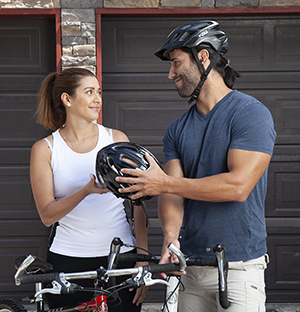Exercising with Asthma
Controlling your asthma will give you the freedom to do the sports or activities you enjoy. Even if exercise is not a trigger for you, regular exercise can help improve your health. Some of the information below applies to everyone, with or without asthma. Other information can help prevent exercise from triggering symptoms. Talk with your healthcare provider before starting to exercise.

Choosing activities
You can be active in many ways:
-
Aerobic exercise. This type of exercise gets your heart and lungs working harder. Examples include jogging, swimming, biking, and walking. Your exercise plan should include at least one regular aerobic activity.
-
Strength training. Building strength means using weights or resistance to build muscles.
-
Lifestyle activities. These include things such as gardening, playing a game of catch, and using the stairs instead of the escalator. These activities may not make you sweat. But they can help you stay in shape. Get in the habit of being active each day.
If exercise is a trigger
-
Swimming. This is a good choice. The air is often warm and moist. It may be less likely to trigger a flare-up. But chlorine fumes from pools are a trigger for some people.
-
Indoor exercise. Exercising indoors is good for days when the weather might trigger symptoms. Try exercising at a gym or at home.
-
Yoga. Yoga provides both stretching and strengthening exercises. It also helps you relax and feel less stressed.
A word about asthma and athletes
As long as your asthma is under control, there’s almost no limit to what you can do. So if you’re an athlete, talk with your healthcare provider about a treatment plan that's right for you. It may help to know that many professional athletes and Olympic gold medal winners have asthma. They are able to do well only if their asthma is under control. The same is true for you.
Exercise tips
Make it fun! Choose activities you enjoy. Exercise with a friend. Listen to music. Get the most out of exercise by:
-
Warming up for at least 5 to 10 minutes. This helps get your heart and muscles ready to go. It also reduces your chances of having symptoms.
-
Drinking plenty of water when you exercise. This keeps your body from losing too much fluid.
-
Taking it easy when you have a cold or other illness.
-
Cooling down after your exercise for at least 5 minutes. Move at a slower pace. Then finish by stretching.
-
Being cautious in cold weather. You may need to increase the length of your warmup and wear a mask. To play it really safe, exercise indoors when it’s cold out.
-
Being aware of how your asthma reacts when you take part in sports or activities that need constant movement. This includes long-distance running and soccer.
-
Using your quick-relief medicine before vigorous exercise. Do this if exercise is a trigger.
-
Wearing a medic alert bracelet or necklace.
My exercise plan
Work with your healthcare provider to create an exercise plan. A common goal is to exercise 30 minutes or more on most days.
☐ Exercise is a trigger for me.
Online Medical Reviewer:
Chris Southard RN
Online Medical Reviewer:
Rajadurai Samnishanth Researcher
Online Medical Reviewer:
Rita Sather RN
Date Last Reviewed:
4/1/2024
© 2000-2024 The StayWell Company, LLC. All rights reserved. This information is not intended as a substitute for professional medical care. Always follow your healthcare professional's instructions.